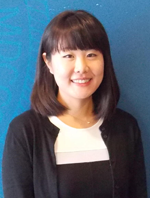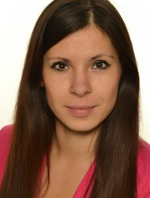AASP Newsletter - February 2017
International Students' Experiences in Sport and Exercise Psychology
Sae-Mi Lee, MS, MA, West Virginia University
Adisa Haznadar, MSc, Springfield College

 I, Sammy, grew up in South Korea and obtained my Bachelor’s degree in Exercise and Sport Sciences, as well as Psychology. I, Adisa, grew up in Sarajevo, Bosnia and Herzegovina where I obtained my Bachelor’s degree in Psychology. Despite our different backgrounds, we share a similar career trajectory in Sport and Exercise Psychology (SEP). Both of us started our training in SEP in Europe: Sammy in Finland and Germany through the University of Jyväskylä’s Master’s program and Adisa in Greece and Germany through the European Masters Program in Sport and Exercise Psychology (EMSEP). EMSEP was a one of a kind program that allowed students to primarily receive training at one host university (in Greece, Finland, or Sweden), but then all meet at Leipzig University (Germany) for one semester. The program was truly unique because it was built on the idea of international exchange; students had the opportunity to study with colleagues and professors from all over the world, which – in our personal experience – was extremely valuable. It was eye-opening to learn how everyone approached SEP (not to mention life!) in different ways. We remember having to question a lot of our taken-for-granted assumptions, even while socializing with each other, such as how we each conceptualized time or effective communication. A benefit, we believe, of studying SEP in Europe was that there were ample opportunities for studying abroad and for cultural exchanges. For example, in addition to the study abroad period in Leipzig, there were/are several two-week exchange programs organized in different European countries. FEPSAC, the European Federation of Sport Psychology’s professional organization, offers many opportunities for students to get involved. In retrospect, we both took these cross-cultural exchanges for granted at the time because it was an opportunity presented to us on such regular basis. We tried to network as much as possible, and the relationships we developed during this time subsequently led both of us to our current respective graduate programs, and helped to establish research collaborations that continue to this day.
I, Sammy, grew up in South Korea and obtained my Bachelor’s degree in Exercise and Sport Sciences, as well as Psychology. I, Adisa, grew up in Sarajevo, Bosnia and Herzegovina where I obtained my Bachelor’s degree in Psychology. Despite our different backgrounds, we share a similar career trajectory in Sport and Exercise Psychology (SEP). Both of us started our training in SEP in Europe: Sammy in Finland and Germany through the University of Jyväskylä’s Master’s program and Adisa in Greece and Germany through the European Masters Program in Sport and Exercise Psychology (EMSEP). EMSEP was a one of a kind program that allowed students to primarily receive training at one host university (in Greece, Finland, or Sweden), but then all meet at Leipzig University (Germany) for one semester. The program was truly unique because it was built on the idea of international exchange; students had the opportunity to study with colleagues and professors from all over the world, which – in our personal experience – was extremely valuable. It was eye-opening to learn how everyone approached SEP (not to mention life!) in different ways. We remember having to question a lot of our taken-for-granted assumptions, even while socializing with each other, such as how we each conceptualized time or effective communication. A benefit, we believe, of studying SEP in Europe was that there were ample opportunities for studying abroad and for cultural exchanges. For example, in addition to the study abroad period in Leipzig, there were/are several two-week exchange programs organized in different European countries. FEPSAC, the European Federation of Sport Psychology’s professional organization, offers many opportunities for students to get involved. In retrospect, we both took these cross-cultural exchanges for granted at the time because it was an opportunity presented to us on such regular basis. We tried to network as much as possible, and the relationships we developed during this time subsequently led both of us to our current respective graduate programs, and helped to establish research collaborations that continue to this day.
What eventually led both of us, however, to leave Europe for the U.S. was a desire to be involved in applied work. In Europe, the graduate programs were more likely to be research-focused and practical opportunities were not as frequent or structured as they are in the U.S. We were eager to be involved in more applied work and structured supervision because it was more consistent with our interests and needs at the time. We both came to the U.S. for our doctorates with a desire to bridge the gap between theory and practice: Sae-Mi to pursue a Ph.D. in SEP and a M.A. in Counseling at West Virginia University and Adisa to pursue a Psy.D. in Counseling Psychology with an Athletic Counseling concentration at Springfield College. Several things stood out to us once we came to the U.S.
Adisa’s Experience at Springfield College
Once I came to the States and became part of the counseling psychology program with an emphasis on athletic counseling, I became more aware of cultural implications and diversity. Being in a field where these conversations are welcomed and fostered, I felt encouraged to voice my opinion during my training and actively incorporate it in my current work. The awareness of the importance of cultural competence helps me bring my counselor identity to my sport psychologist identity when working with athletes to invite openness to cultural diversity.
Sammy’s Reflections about her time in West Virginia
For me, the Eurocentric assumptions of the field of SEP (Ryba, Stambulova, Si, & Schinke, 2013) and AASP became somewhat more evident once I was in the U.S. There were taken-for-granted assumptions about practices in the U.S. and, perhaps because I was an international student, I did not share some of these assumptions, and cultural influences were made more explicit to me. For example, what counts as quality supervision was different depending on the culture I was in. Thanks to my training and lived experiences, I increasingly realized that knowledge and disciplines (SEP) are culturally situated rather than universal. This led me to realize the importance of cultural competence, which is now the focus of all my scholarly activities.
As both of us are finishing our degrees this year, we are actively planning our next steps as international early career professionals. To be honest, career planning is much more complex for international students than we originally understood. One of the benefits and privileges we have as international students is the mental preparedness and opportunities to relocate anywhere in the world; this is something we have already done many times at this point! However, there are logistics that international professionals have to navigate. As Adisa is clinically trained, her training best prepares her for a job in the U.S. Although she could technically return to Europe and Bosnia if she wanted, she would need to go through additional steps for licensure and many other processes to transfer all her credentials and have her expertise recognized elsewhere. If she stays in the U.S., she needs to navigate the legalities of visa sponsorship, which is something that will shape and, at times, limit her job opportunities. I, Sammy, am more open to pursuing a job regardless of geographical location, but this presents its own set of considerations. I constantly think about the cultural relevance and applicability of what I am learning/doing to where I may potentially be working which, frankly, can be confusing.
For these reasons, despite our passion for applied work and continued involvement with AASP, at times, we find the perspectives limiting and/or irrelevant for non-U.S. students like us. For example, many AASP members are not aware of training opportunities and requirements outside of the U.S., which can lead to great difficulties for international students to get AASP certification. Moreover, the “golden standard” rhetoric of AASP certification and our inability to fit it neatly due to our international training, led us to feel our international background is not only underappreciated, but even seen as a hindrance at times rather than a strength and asset. Furthermore, career considerations and guidance for international students and professionals has been harder to come by. We have been truly lucky to be involved with AASP’s International Relations Committee and EMSEP, as various international colleagues and mentors with whom we have been fortunate enough to engage were vital to both of our personal and professional development. They help us navigate the logistics and the complexities of being an international professional in the U.S. However, we hope that AASP as an organization shows greater efforts to truly be an international organization that represents non-U.S. students and professionals by actively and explicitly incorporating non-U.S. and non-Eurocentric perspectives and increasing support for cross-cultural exchanges and conversations. We believe these strides will help AASP continue to become more inclusive and relevant to a broader international membership.
References
Ryba, T. V., Stambulova, N. B., Si, G., & Schinke, R. J. (2013). ISSP position stand: Culturally competent research and practice in sport and exercise psychology. International Journal of Sport and Exercise Psychology, 11(2), 123–142.



